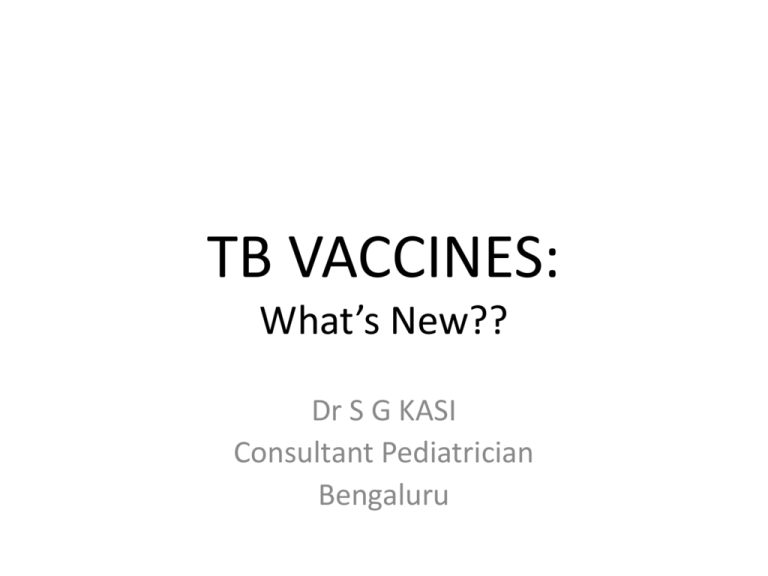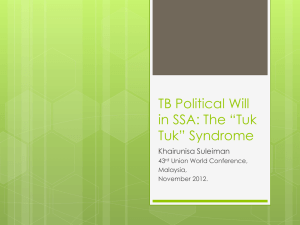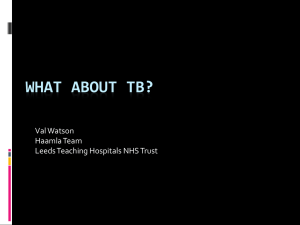TB VACCINES: What's New??
advertisement

TB VACCINES: What’s New?? Dr S G KASI Consultant Pediatrician Bengaluru Existing TB Vaccine Ineffective • BCG unreliable against pulmonary TB, which accounts for most TB disease worldwide • BCG is not known to protect against latent TB • BCG is not recommended for use in infants infected with HIV - increased risk for severe BCGrelated complications • Despite wide use, BCG has had no apparent impact on the growing global TB epidemic • BCG does reduce risk of severe pediatric TB disease, so it should continue to be used until a better TB vaccine is available BCG introduced in 1921 TB Vaccine Pipeline As of November 2009 Phase I Preclinical Phase II AERAS-422 VPM 1002 Hybrid-I+IC31 Aeras Max Planck, Vakzine Projekt Mgmt, TBVI SSI, TBVI, Intercell rBCG30* M72 UCLA, NIH, NIAID, Aeras GSK, Aeras Mtb [∆lysA ∆panCD ∆secA2] Albert Einstein College of Medicine MTBVAC01 [∆phoP, ∆fad D26] AdAg85A University of Zaragoza, Institute Pasteur, TuBerculosis Vaccine Initiative (TBVI) Hybrid-I+CAF01 HBHA McMaster University Phase IIb MVA85A/ AERAS-485 Phase III M vaccae* Immodulon, NIH Oxford-Emergent Tuberculosis Consortium (OETC), Aeras AERAS-402/ Crucell Ad35 Crucell, Aeras SSI Hyvac 4/ AERAS-404 Institute Pasteur of Lille, INSERM, TBVI SSI, Sanofi-Pasteur, Aeras, Intercell Hybrid 56 RUTI Statens Serum Institute (SSI), Aeras, Intercell, TBVI M smegmatis* Archivel Farma Prime Boost Post-infection HG85 A/B Shanghai H&G Biotech Preclinical vaccine candidates are not yet in clinical trials, but have been manufactured under Good Manufacturing Practice (GMP) for clinical use and have undergone some preclinical testing that meets regulatory standards. *indicates candidates that have been in clinical trials in the past, but are not currently being tested in clinical trials Source: Tuberculosis Vaccine Candidates – 2009; Stop TB Partnership Working Group on New TB Vaccines Immunotherapy New TB vaccines in Clinical Development R-BCG PRIME VACCINES: VPM1002 rBCGDureC:Hly • Expresses listeriolysin (Hly) derived from Listeria monocytogenes and enables BCG to escape from the endosome. • Made urease-C-deficient to provide the optimal pH for Hly activity . • A Phase I clinical trial evaluating the safety and immunogenicity of this vaccine in healthy male subjects has been completed • A dose-escalation RCT (Phase 2a)comparing the safety and immunogenicity of VPM1002 and BCG in healthy adults in South Africa is ongoing AERAS-422 (rBCG) • Genetically modify BCG such that it overexpresses one or more major secretory proteins, early targets for the host immune response against M Tb (antigen 85B) . • In a Phase I RCT, rBCG30 was well tolerated and had a comparable safety profile to nonrecombinant Tice BCG. • Antigen 85B-specific T-cell proliferation and IFN-g ELISpot responses were enhanced and antigen specific CD4+ and CD8+ effector T-cell expansion was demonstrated • The antigen 85B-specific T cells induced were also capable of inhibiting the growth of intracellular mycobacteria AERAS-422 (research strain AFRO-1) • Recombinant BCG Danish 1331 strain • Expresses perfringolysin O as an endosome escape mechanism • Overexpresses immunodominant and protective M. tuberculosis antigens, 85A, 85B and Rv3407 • A Phase I clinical trial in healthy human subjects will soon be starting in the USA Subunit vaccines designed to enhance BCG • Enhance the effectiveness of BCG. • Regimens would retain BCG vaccination of neonates • Involve the delivery of immunodominant mycobacterial antigens to the immune system, using: 1. Viral vectored vaccines 2. Protein – adjuvant vaccines MVA85A • MVA as a delivery system for the mycobacterial antigen 85A • Evaluated in a series of Phase I clinical trials in healthy adults in the UK since 2002, including BCGvaccinated subjects and subjects with LTBI • Phase I and IIa clinical trials in target populations in South Africa, The Gambia and Senegal • Has been safely administered to high-risk target populations, namely HIV-infected adults, subjects coinfected with HIV and M. tuberculosis and infants Results of MVA85 so far… • High frequencies of antigen-specific IFN-g-producing polyfunctional CD4+ T cells are induced • Expansion of a memory population • Frequency of antigen-specific cells remains significantly higher than baseline for at least 1 year after vaccination • Antigen-specific, IFN-g-producing CD8+ T cells have also been detected • A Phase IIb efficacy trial in BCG-vaccinated South African infants is now underway MVA85A in HIV+ adults • A Phase I study evaluating the safety and immunogenicity of MVA85A, a candidate TB vaccine, in HIV-infected adults. BMJ Open 2011;1:e000223. doi:10.1136/ bmjopen-2011-000223 • MVA85A was safe in subjects with HIV infection, • No clinically significant vaccine-related changes in CD4 count or HIV RNA load in any subjects, • Both doses of MVA85A induced an antigen-specific IFNresponse that was durable for 24 weeks, • The functional quality of the vaccine-induced T cell response in HIV-infected subjects was remarkably comparable with that observed in healthy HIV-uninfected controls MVA 85A in Infants • Dose-Finding Study of the Novel Tuberculosis Vaccine, MVA85A, in Healthy BCG-Vaccinated Infants. JID 2011;203:1832–43 • Infants aged 5–12 months were vaccinated intradermally with either of 3 escalating dose schedule of MVA85A, or placebo. • MVA85A induced potent, durable T-cell responses, which exceeded prevaccination responses up to 168 days after vaccination. • Conclusions. MVA85A was safe and induced robust, polyfunctional, durable CD4 and CD8 T-cell responses in infants. These data support efficacy evaluation of MVA85A to prevent tuberculosis in infancy. MVA85 & EPI Vaccines • Immunogenicity of the Tuberculosis Vaccine MVA85A Is Reduced by Coadministration with EPI Vaccines in a Randomized Controlled Trial in Gambian Infants Sci Transl Med 22 June 2011: Vol. 3, Issue 88, p. 88ra56 • Coadministration of MVA85A with EPI vaccines was associated with a significant reduction in MVA85A immunogenicity, but did not affect humoral responses to the EPI vaccines • Suggest that modifications to the standard EPI schedule may be required to incorporate a new generation of T cell– inducing vaccines. AERAS-402/Crucell Ad35 • Nonreplicating adenovirus (Ad) type 35 as vector • Expressing a fusion protein of mycobacterial antigens 85A, 85B and TB10.4 • IM administration of AERAS-402 was well tolerated and induced polyfunctional CD4+ T cells and IFN-g-producing CD8+ T cells in response to antigen stimulation with antigens 85A, 85B and TB10.4 AERAS-402/Crucell Ad35 2 • A Phase II trial in South Africa is recruiting HIV-infected, BCGvaccinated adults and assessing the safety (including effect on CD4 count) and immunogenicity • In Kenya, a Phase I and II safety, immunogenicity and efficacy trial in BCG-vaccinated, HIV-uninfected infants is ongoing Protein–adjuvant vaccines • Adjuvants used may be – aluminium based compounds or immunopotentiating agents eg, TLR ligands, saponins, cytokines and bacterial toxins M72 • Fusion of two proteins, Mtb32 and Mtb39, • Formulated in the adjuvant AS02A- oil-in-water emulsion and the immunostimulants 3-deacylated monophosphoryl lipid A (MPL) and QS-21, a detergent purified from the bark of Quillaja saponaria • Well tolerated in a Phase I trial of PPD-healthy adult subjects in the USA and induced antigen-specif ic IFN-g and IL-2 production and CD4+ T cells • Phase IIa trials in TST-positive healthy adults in a TB-endemic area (South Africa) and of different formulations in the Philippines have also been completed. Hybrid 1 • Fusion protein of antigens 85B and ESAT-6 • Hybrid 1, adjuvanted with IC31, in a Phase I trial in PPDnegative healthy adults, was associated with antigen-specific T-cell responses. The T-cell responses were maintained for 2 years • Hybrid 1 formulated with a novel liposomal adjuvant, cationic adjuvant formulation (CAF01), is now in an open-label Phase I clinical trial in The Netherlands Therapeutic vaccines in clinical trials • Mycobacterium vaccae : 1 dose not very effective. 5 doses in BCG-vaccinated, HIV-infected patients in Tanzania demonstrated significant protection against the secondary end point of definite (culture positive) TB, although not against the primary end point of disseminated (bacteremic) disease or against the other secondary end point, probable TB • RUTI® (Archivel Farma): detoxified liposomal cellular fragments of M. tuberculosis bacilli. In a double-blind Phase I RCT in BCG-naive healthy men in Spain, RUTI was well tolerated and associated with modestly enhanced responses to PPD and mycobacterial antigens, including ESAT-6 and 85B . THE INDIAN CONTRIBUTION….. • Cellular Immune Responses to Nine Mtb Vaccine Candidates following Intranasal Vaccination. PLoS ONE 6(7): e22718. • doi:10.1371/journal.pone.0022718, Published July 25, 2011 Suraj B. Sable, Mani Cheruvu, Subhadra Nandakumar, Sunita Sharma,et al • In this study, a comparison of intranasal (i.n.) and subcutaneous (s.c.) vaccination with the BCG vaccine demonstrated that a single moderate dose delivered intranasally induced a stronger and sustained M. tuberculosisspecific T-cell response in lung parenchyma and cervical lymph nodes of BALB/c mice than vaccine delivered subcutaneously. • A Booster Vaccine Expressing a Latency-Associated Antigen Augments BCG Induced Immunity and Confers Enhanced Protection against Tuberculosis Bappaditya Dey., Ruchi Jain., Umesh D. Gupta, V. M. Katoch, V. D. Ramanathan, Anil K. Tyagi Department of Biochemistry, University of Delhi South Campus, New Delhi, India, 2 National JALMA Institute for Leprosy and Other Mycobacterial Diseases, Agra, Uttar Pradesh, India, 3Department of Clinical Pathology, Tuberculosis Research Center, Chennai, Tamil Nadu, India • Evaluated the ability of a DNA vaccine expressing a-crystallina key latency antigen of Mtb to boost the BCG induced immunity • ‘BCG prime – DNA boost’ regimen (B/D) confers robust protection in guinea pigs along with a reduced pathology in comparison to BCG vaccination • B/D immunization in mice results in a heightened frequency of PPD and antigen specific multi-functional CD4 T cells (3+) simultaneously producing interferon (IFN)c, tumor necrosis factor (TNF)a and interleukin (IL)2. Novel TB Vaccines: Cost effective? • Cost-effectiveness of novel vaccines for tuberculosis control: a decision analysis study. BMC Public Health 2011, 11:55 • • http://www.biomedcentral.com/1471-2458/11/55 Chia-Lin Tseng, Olivia Oxlade, Dick Menzies, Anne Aspler, Kevin Schwartzman • Conclusions: Investment in an improved TB vaccine is predicted to result in considerable cost savings, as well as a reduction in TB morbidity and TB-related mortality, when added to existing control strategies. For a vaccine with waning efficacy, a prime-boost strategy is more cost-effective in the long term.






